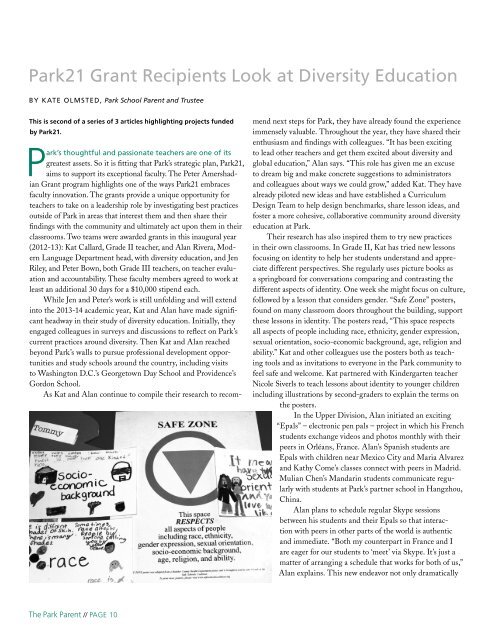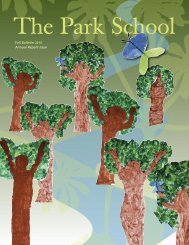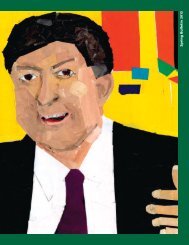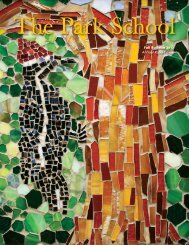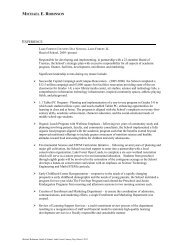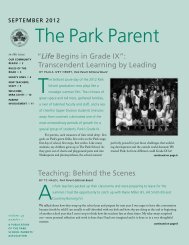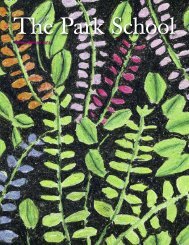The Park Parent April-May 2013 - The Park School
The Park Parent April-May 2013 - The Park School
The Park Parent April-May 2013 - The Park School
Create successful ePaper yourself
Turn your PDF publications into a flip-book with our unique Google optimized e-Paper software.
<strong>Park</strong>21 Grant Recipients Look at Diversity EducationBY KATE OLMSTED, <strong>Park</strong> <strong>School</strong> <strong>Parent</strong> and TrusteeThis is second of a series of 3 articles highlighting projects fundedby <strong>Park</strong>21.<strong>Park</strong>’s thoughtful and passionate teachers are one of itsgreatest assets. So it is fitting that <strong>Park</strong>’s strategic plan, <strong>Park</strong>21,aims to support its exceptional faculty. <strong>The</strong> Peter AmershadianGrant program highlights one of the ways <strong>Park</strong>21 embracesfaculty innovation. <strong>The</strong> grants provide a unique opportunity forteachers to take on a leadership role by investigating best practicesoutside of <strong>Park</strong> in areas that interest them and then share theirfindings with the community and ultimately act upon them in theirclassrooms. Two teams were awarded grants in this inaugural year(2012-13): Kat Callard, Grade II teacher, and Alan Rivera, ModernLanguage Department head, with diversity education, and JenRiley, and Peter Bown, both Grade III teachers, on teacher evaluationand accountability. <strong>The</strong>se faculty members agreed to work atleast an additional 30 days for a $10,000 stipend each.While Jen and Peter’s work is still unfolding and will extendinto the <strong>2013</strong>-14 academic year, Kat and Alan have made significantheadway in their study of diversity education. Initially, theyengaged colleagues in surveys and discussions to reflect on <strong>Park</strong>’scurrent practices around diversity. <strong>The</strong>n Kat and Alan reachedbeyond <strong>Park</strong>’s walls to pursue professional development opportunitiesand study schools around the country, including visitsto Washington D.C.’s Georgetown Day <strong>School</strong> and Providence’sGordon <strong>School</strong>.As Kat and Alan continue to compile their research to recommendnext steps for <strong>Park</strong>, they have already found the experienceimmensely valuable. Throughout the year, they have shared theirenthusiasm and findings with colleagues. “It has been excitingto lead other teachers and get them excited about diversity andglobal education,” Alan says. “This role has given me an excuseto dream big and make concrete suggestions to administratorsand colleagues about ways we could grow,” added Kat. <strong>The</strong>y havealready piloted new ideas and have established a CurriculumDesign Team to help design benchmarks, share lesson ideas, andfoster a more cohesive, collaborative community around diversityeducation at <strong>Park</strong>.<strong>The</strong>ir research has also inspired them to try new practicesin their own classrooms. In Grade II, Kat has tried new lessonsfocusing on identity to help her students understand and appreciatedifferent perspectives. She regularly uses picture books asa springboard for conversations comparing and contrasting thedifferent aspects of identity. One week she might focus on culture,followed by a lesson that considers gender. “Safe Zone” posters,found on many classroom doors throughout the building, supportthese lessons in identity. <strong>The</strong> posters read, “This space respectsall aspects of people including race, ethnicity, gender expression,sexual orientation, socio-economic background, age, religion andability.” Kat and other colleagues use the posters both as teachingtools and as invitations to everyone in the <strong>Park</strong> community tofeel safe and welcome. Kat partnered with Kindergarten teacherNicole Siverls to teach lessons about identity to younger childrenincluding illustrations by second-graders to explain the terms onthe posters.In the Upper Division, Alan initiated an exciting“Epals” – electronic pen pals – project in which his Frenchstudents exchange videos and photos monthly with theirpeers in Orléans, France. Alan’s Spanish students areEpals with children near Mexico City and Maria Alvarezand Kathy Come’s classes connect with peers in Madrid.Mulian Chen’s Mandarin students communicate regularlywith students at <strong>Park</strong>’s partner school in Hangzhou,China.Alan plans to schedule regular Skype sessionsbetween his students and their Epals so that interactionwith peers in other parts of the world is authenticand immediate. “Both my counterpart in France and Iare eager for our students to ‘meet’ via Skype. It’s just amatter of arranging a schedule that works for both of us,”Alan explains. This new endeavor not only dramatically<strong>The</strong> <strong>Park</strong> <strong>Parent</strong> // PAGE 10


